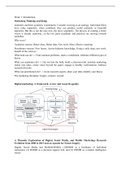Samenvatting
Summary Digital and Social Media Strategies exam preparations!
Summary of the papers and lecture slides of Digital and Social Media Strategies (DSMS) of Lachlan Deer. Made for the exam of Passed this class with an 8 and thereby positioned myself in the top 10% of this class
[Meer zien]





